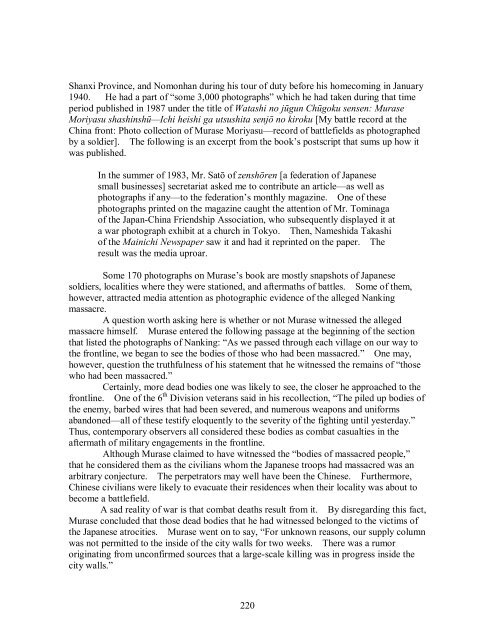Analyzing the âPhotographic Evidenceâ of the Nanking Massacre
Analyzing the âPhotographic Evidenceâ of the Nanking Massacre
Analyzing the âPhotographic Evidenceâ of the Nanking Massacre
Create successful ePaper yourself
Turn your PDF publications into a flip-book with our unique Google optimized e-Paper software.
Shanxi Province, and Nomonhan during his tour <strong>of</strong> duty before his homecoming in January1940. He had a part <strong>of</strong> “some 3,000 photographs” which he had taken during that timeperiod published in 1987 under <strong>the</strong> title <strong>of</strong> Watashi no jūgun Chūgoku sensen: MuraseMoriyasu shashinshū—Ichi heishi ga utsushita senjō no kiroku [My battle record at <strong>the</strong>China front: Photo collection <strong>of</strong> Murase Moriyasu—record <strong>of</strong> battlefields as photographedby a soldier]. The following is an excerpt from <strong>the</strong> book’s postscript that sums up how itwas published.In <strong>the</strong> summer <strong>of</strong> 1983, Mr. Satō <strong>of</strong> zenshōren [a federation <strong>of</strong> Japanesesmall businesses] secretariat asked me to contribute an article—as well asphotographs if any—to <strong>the</strong> federation’s monthly magazine. One <strong>of</strong> <strong>the</strong>sephotographs printed on <strong>the</strong> magazine caught <strong>the</strong> attention <strong>of</strong> Mr. Tominaga<strong>of</strong> <strong>the</strong> Japan-China Friendship Association, who subsequently displayed it ata war photograph exhibit at a church in Tokyo. Then, Nameshida Takashi<strong>of</strong> <strong>the</strong> Mainichi Newspaper saw it and had it reprinted on <strong>the</strong> paper. Theresult was <strong>the</strong> media uproar.Some 170 photographs on Murase’s book are mostly snapshots <strong>of</strong> Japanesesoldiers, localities where <strong>the</strong>y were stationed, and aftermaths <strong>of</strong> battles. Some <strong>of</strong> <strong>the</strong>m,however, attracted media attention as photographic evidence <strong>of</strong> <strong>the</strong> alleged <strong>Nanking</strong>massacre.A question worth asking here is whe<strong>the</strong>r or not Murase witnessed <strong>the</strong> allegedmassacre himself. Murase entered <strong>the</strong> following passage at <strong>the</strong> beginning <strong>of</strong> <strong>the</strong> sectionthat listed <strong>the</strong> photographs <strong>of</strong> <strong>Nanking</strong>: “As we passed through each village on our way to<strong>the</strong> frontline, we began to see <strong>the</strong> bodies <strong>of</strong> those who had been massacred.” One may,however, question <strong>the</strong> truthfulness <strong>of</strong> his statement that he witnessed <strong>the</strong> remains <strong>of</strong> “thosewho had been massacred.”Certainly, more dead bodies one was likely to see, <strong>the</strong> closer he approached to <strong>the</strong>frontline. One <strong>of</strong> <strong>the</strong> 6 th Division veterans said in his recollection, “The piled up bodies <strong>of</strong><strong>the</strong> enemy, barbed wires that had been severed, and numerous weapons and uniformsabandoned—all <strong>of</strong> <strong>the</strong>se testify eloquently to <strong>the</strong> severity <strong>of</strong> <strong>the</strong> fighting until yesterday.”Thus, contemporary observers all considered <strong>the</strong>se bodies as combat casualties in <strong>the</strong>aftermath <strong>of</strong> military engagements in <strong>the</strong> frontline.Although Murase claimed to have witnessed <strong>the</strong> “bodies <strong>of</strong> massacred people,”that he considered <strong>the</strong>m as <strong>the</strong> civilians whom <strong>the</strong> Japanese troops had massacred was anarbitrary conjecture. The perpetrators may well have been <strong>the</strong> Chinese. Fur<strong>the</strong>rmore,Chinese civilians were likely to evacuate <strong>the</strong>ir residences when <strong>the</strong>ir locality was about tobecome a battlefield.A sad reality <strong>of</strong> war is that combat deaths result from it. By disregarding this fact,Murase concluded that those dead bodies that he had witnessed belonged to <strong>the</strong> victims <strong>of</strong><strong>the</strong> Japanese atrocities. Murase went on to say, “For unknown reasons, our supply columnwas not permitted to <strong>the</strong> inside <strong>of</strong> <strong>the</strong> city walls for two weeks. There was a rumororiginating from unconfirmed sources that a large-scale killing was in progress inside <strong>the</strong>city walls.”220












